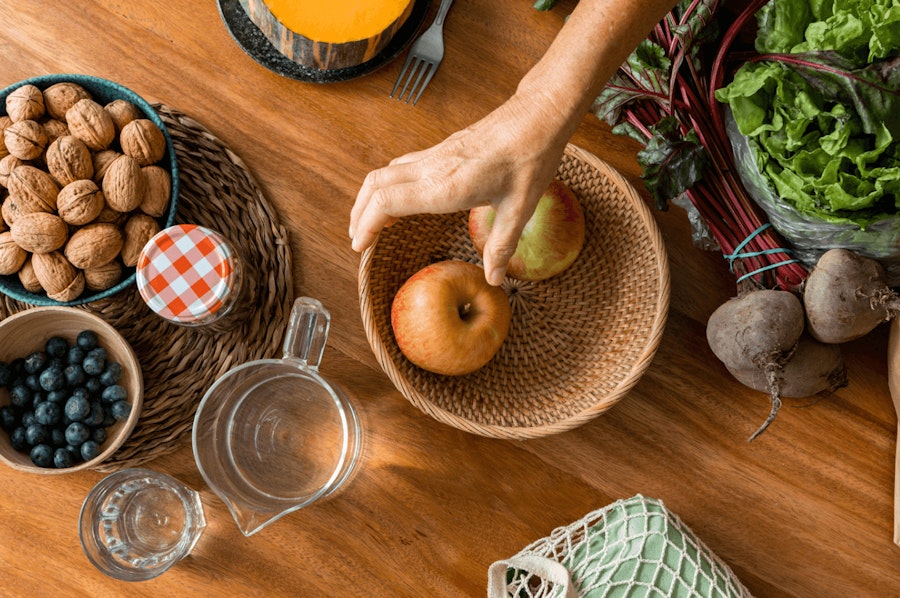5 Foods that help with period cramps
This post looks at some types of food that may help you manage your own period pain. However, everyone is different, with different pain thresholds, allergies, intolerances, and preferences. It’s important to seek medical advice if you are suffering from severe pain every period — this helps your doctor rule out any other causes of pain, and offer treatment options. Now, let’s take a look at some food that can help with dysmenorrhea (yes, that’s the technical term for period cramps)!
1. Fresh fruit
If you want to alleviate period cramps, then you may need to look no further than your fruit bowl. Fresh fruit and vegetables have so many health benefits already, but evidence suggests upping your fruit intake can also help reduce menstrual pain. In fact, one study found that participants who ate just two portions of fruit per day had significantly reduced cramping as a result.
There are many possible reasons why fresh fruit could be helpful during painful periods, including the antioxidant properties found in citrus fruit such as oranges and lemons, or the high magnesium content found in bananas. (Research has found magnesium supplements may also reduce menstrual pain.)
If you crave sugary snacks during your period, eating fruit can also help banish these cravings, and may in turn lead to less bloating and discomfort as a result of not reaching for processed and sugary foods.
2. Fish containing Omega 3
Omega 3 is a fatty acid that’s found in certain types of oily fish. It’s got many useful benefits including helping maintain a healthy heart and brain. However, evidence suggests it can also alleviate period pain too! A small study of 100 women aged 18-22 looked at the impact of taking Omega 3 supplements over the course of three months. The study found taking these supplements resulted in reduced period pain. A similar study also found a significant decrease in period pain after two months of taking a supplement of fish oil daily.
Omega 3 supplements can be bought in most drug stores or pharmacies, but if you want to add more seafood to your diet, it is primarily found in oily fish such as salmon, sardines, mackerel, and anchovies. In the U.S. the dietary guidelines for adult women of childbearing age is 4 oz up to twice a week, from low mercury choices of fish.
3. Dark chocolate
On the sweeter side of the spectrum, chocolate that’s rich in cacao has also been shown to help with cramps. One study looked at the effects of dark chocolate to help with period pain. The results showed that both the chocolate and the music helped ease menstrual pain. This is good news if you’re someone who already craves chocolate on your period.
Keep in mind that the evidence that’s out there looks specifically at dark chocolate. In fact, more sugary options (such as white and milk chocolate) may actually make period symptoms worse! So if you’re stocking up, make sure you buy a bar with at least 70% cocoa content.
4. Olive oil
A Mediterranean diet has long been praised for its wide health benefits, and may even increase your lifespan! Olive oil is a key ingredient in this diet, and it seems this plant-based wonder food may have even more good side effects. New evidence suggests it could even reduce menstrual discomfort when used regularly.
Adding olive oil to your diet is pretty simple, you can use it as a dressing in salads or drizzle it over dishes of meat, fish, or vegetables. It’s also delicious served as a dip with fresh bread.
5. Ginger
There are several herbs and spices that are associated with helping soothe menstrual symptoms including bloating, headaches, and tiredness. We’re focusing on ginger as there have been several studies that show this humble root can help specifically with period pain.
Ginger is a popular health food because of its many claimed benefits. More evidence is needed to determine just how good ginger is for us, but its zingy, zesty taste is certainly invigorating! Ginger is a hugely versatile ingredient that works well in both savory and sweet dishes. Add it to stir fry, stews, curries, smoothies and juices, and see if it helps banish your cramps.
Other ways to manage menstrual pain
So many factors can impact how we’re feeling, including how much sleep we get, how stressed we are, and how much we move. Being mindful of what you eat can help too, but also try these extra tips which may help reduce period cramps and other PMS symptoms:
Stay hydrated - Upping your water intake can make you feel less bloated, it can also help with other painful symptoms such as headaches, and help clear up breakouts.
Get moving - While hard cardio on your period might be pretty far down your list of priorities, there are a few gentle movements you can try instead. Go for a walk, join a yoga class, or try out these exercises for period cramps.
Cut down on caffeine and alcohol - Whether you enjoy a coffee first thing to kick start your day, or a glass of wine in the evening to help you wind down, both caffeine and alcohol may actually make period symptoms worse.
Be kind to yourself - Above all else, we urge you to take care of YOU. Don’t beat yourself up if you don’t do any of the above. Make time to rest, and avoid pushing through pain.
Take control of your cycle
Thanks for reading up on the foods that help with period cramps! At Natural Cycles we’re passionate about spreading knowledge when it comes to reproductive health. Our app is the first FDA Cleared birth control of its kind, helping you to plan or prevent pregnancy completely hormone-free! Get period predictions, PMS alerts, and more when you sign up for Natural Cycles today.
Did you enjoy reading this article?
